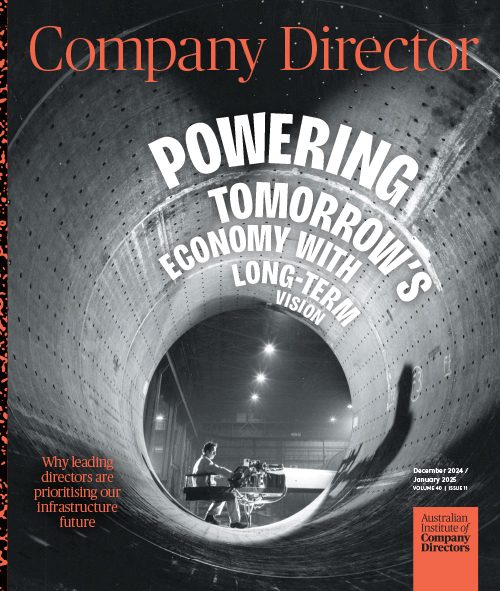Recent research reveals 85 per cent of ASX 200 CEOs are ineffective on LinkedIn. A new AICD webinar outlines how leaders can use social media to improve their business reputation, writes Propel MD Roger Christie.
If you woke to news of a cybersecurity attack tomorrow, where and how would your organisation respond? You could issue a statement on your corporate website. You might contact journalists to provide basic details. You might even email key stakeholders with an update to try to get on the front foot.
But what about your CEO’s LinkedIn profile? Would you use social media — which provides direct, immediate access to your most important stakeholders — to outline the facts, demonstrate control and leadership, and reassure people in a more human way? Or would you stay silent?
This was the harrowing reality faced by both Optus and Medibank last year. Interestingly, within 24 hours of a cyberattack, Medibank CEO David Koczkar MAICD had posted an update about the attack via his own LinkedIn profile, linking to the corporate website.
In response, he received a number of overwhelmingly positive messages. His choice to communicate quickly, directly and personally via LinkedIn meant the concerning news was first seen by those closest to the CEO — a strategy that generated more praise and understanding than criticism.
However, this is not a common approach taken by business leaders. A survey conducted by digital advisory firm Propel reveals that 85 per cent of ASX 200 CEOs do not have an adequate presence on LinkedIn. The Digital Reputation Report examined the behaviours of ASX 200 CEOs on LinkedIn to better understand how leaders from our largest listed organisations are using the platform. Rather than widespread adoption, we found that almost 85 per cent of CEOs are either “invisible, inactive or ineffective” on LinkedIn. In fact, only six per cent were considered “very active”. Koczkar was one of these select few.
The figures reveal the alarming social media gap we have amongst the highest level of leadership across the country. For example, nearly 70 per cent of all ASX 200 CEOs with a LinkedIn profile only posted five times or less in almost 12 months. More than 50 per cent posted just once or not at all in that same period. And just five per cent of CEOs have more followers (52 per cent) than the remaining 95 per cent of CEOs combined.
“Leadership is simply a series of moments and every moment offers the opportunity to leave a positive legacy,” says leadership expert, author and director Dr Kirstin Ferguson AM FAICD. In a recent conversation shared on the Your Digital Reputation podcast, she explained the impact of a leader’s choices and actions, whether on or offline today. “Many people look online to see who their bosses are going to be, and what they think about issues in the world. If you don’t have a presence at all, it really says something about the kind of leader you are.”
Ferguson’s views are consistent with industry data. According to global advisory firm Brunswick Group, 82 per cent of people now expect leaders to use social media to communicate their mission, vision and values — not just the corporate script. People are also four times more willing to work for leaders who use social media than those who do not.
Make a yourself heard
Beyond customers and candidates, what does Brunswick say about the shareholder impact of social media? Financial readers trust leaders who use social nine times more than leaders who do not. In short, the choices leaders make on social media today have a direct impact on where people invest tomorrow — both their hard-earned cash and their careers. Silence, not participation, is the far greater risk.
Digital anonymity wasn’t an effective strategy in 2022 and will not be one in 2023. Today’s leaders must be informed and empowered to engage key audiences online. While avoiding social media may have been a choice in the past, silence increases risk exposure today. Silence relinquishes control of the narrative and creates distance between a leader and their key audiences. Particularly in times of crisis, distance can contribute to fear, anxiety and reputational damage.
It may feel daunting for leaders to lean into a social media world that is constantly changing. But we must start a new conversation in boardrooms about the real role of social media for executives. When your stakeholders most need to hear from you, access is far more valuable than silence.
Where to start on social media
By analysing the efforts of CEOs including Telstra’s Vicki Brady GAICD, ANZ’s Shayne Elliott MAICD and AMP’s Alexis George GAICD, we have identified a series of common traits and actions other leaders can take to reduce risk and build a more purposeful presence online. Here are five steps:
- Analyse key audiences and their behaviours online. Ensure communications experts have done their research to understand the online landscape and issues. Risk mitigation means reading the room before you walk in.
- Audit your executives’ digital presence. Learn how leaders are perceived online, and what results show up when you Google their names. Optimise their profiles for key audiences.
- Set a strategy for success. Define clear objectives for social media activities, based on your executives’ purpose and audience. No leader needs to be on all platforms at all times.
- Build baseline confidence and capability. Knowing how key platforms work — including on smartphones — will save executives time and limit risk. Focus training on core activities like posting, commenting and reactions.
- Operationalise support structures. Monitoring, messaging and measurement are three key resources every executive should have around them. Empower them with experts.
Latest news
Already a member?
Login to view this content


